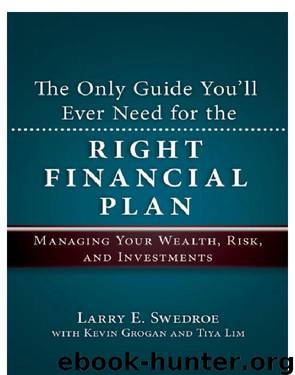The Only Guide You'll Ever Need for the Right Financial Plan by Larry E. Swedroe & Grogan Kevin & Lim Tiya

Author:Larry E. Swedroe & Grogan, Kevin & Lim, Tiya [Grogan, Kevin]
Language: eng
Format: mobi
Publisher: Wiley
Published: 2010-06-30T04:00:00+00:00
Swapping Back
After the wash sale time period has expired, you will likely want to swap back into the original holding. That can create further tax problems. If there is a further loss, there is no problem, as you simply harvest it. However, if there is a gain, it will be short term and taxed at ordinary income-tax rates. Generally, you much prefer to pay taxes at the long-term capital gains rate. Harvesting the prior losses has mitigated part of the problem. You can use the loss to offset gains. By selling only when a reasonably large loss is being harvested (see below), you can maximize the likelihood the harvest ends up being an overall benefit. If the gain during the thirty-one day period required to avoid the wash sale rule in the replacement investment is smaller than the harvested loss, and the replacement fund is not as tax-efficient an investment, then it is generally best to swap back, even if this uses up some of the harvested losses.
Even if the gain is slightly higher than the harvested loss, you may still want to swap back in thirty-one days. For example, if you have swapped a tax-managed fund with a non-tax-managed one, in December you may face even larger capital gain distributions from the replacement investment. A swap back might be warranted.
On the other hand, if the gain from the replacement property is large (for example, 5 percent greater than the harvested loss), you should hold on to the replacement property until the gain becomes long term or prices drop again and swapping back to the original position can be done at low or even no short-term capital gains. In this case, it is recommended you watch the distribution estimates for the replacement investment to make sure distributions won’t be greater than the short-term gain you are trying to avoid. In that instance, you should swap back to the more tax-efficient investment before the distribution.
By waiting until the gain becomes long term, the gain could become substantially larger. You don’t want to pay taxes, even at longer-term rates. You want a swap holding that is both a suitable replacement in terms of asset class exposure and tax efficient (if such an alternative exists), so you are comfortable holding for the long term, if necessary.
In short, to reduce risks, we suggest taking only significant losses. You should establish a minimum percentage loss of the invested assets and a minimum absolute dollar. A loss is large enough to consider harvesting when it exceeds a predetermined hurdle. For example, you might set a hurdle of $5,000 for bonds and 2 percent of the value. For equities, hurdles of $5,000 and 5 percent might be set. However, for highly volatile asset classes like emerging markets or commodities (remembering that in most cases commodities should be held in tax-deferred accounts), the hurdles might be $5,000 and 7.5 percent. The better the fit in terms of asset class exposure and greater the tax efficiency of the fund
Download
This site does not store any files on its server. We only index and link to content provided by other sites. Please contact the content providers to delete copyright contents if any and email us, we'll remove relevant links or contents immediately.
| Analysis & Strategy | Bonds |
| Commodities | Derivatives |
| Futures | Introduction |
| Mutual Funds | Online Trading |
| Options | Portfolio Management |
| Real Estate | Stocks |
Rich Dad Poor Dad by Robert T. Kiyosaki(6414)
Pioneering Portfolio Management by David F. Swensen(6230)
How To Win Friends and Influence People by Dale Carnegie(4447)
The Money Culture by Michael Lewis(4083)
The Dhandho Investor by Mohnish Pabrai(3706)
The Wisdom of Finance by Mihir Desai(3659)
Liar's Poker by Michael Lewis(3372)
Fooled by Randomness: The Hidden Role of Chance in Life and in the Markets by Nassim Nicholas Taleb(3049)
The ONE Thing by Gary Keller(3010)
The Intelligent Investor by Benjamin Graham Jason Zweig(2995)
Mastering Bitcoin: Programming the Open Blockchain by Andreas M. Antonopoulos(2983)
Rich Dad Poor Dad: What The Rich Teach Their Kids About Money - That The Poor And Middle Class Do Not! by Robert T. Kiyosaki(2909)
How to Day Trade for a Living: Tools, Tactics, Money Management, Discipline and Trading Psychology by Andrew Aziz(2909)
Investing For Dummies by Eric Tyson(2894)
How to Win Friends and Influence People by Dale Carnegie(2863)
Market Wizards by Jack D. Schwager(2645)
The Psychology of Money by Morgan Housel(2633)
Zero Hour by Harry S. Dent Jr. & Andrew Pancholi(2614)
How to Pay Zero Taxes, 2018 by Jeff A. Schnepper(2603)
